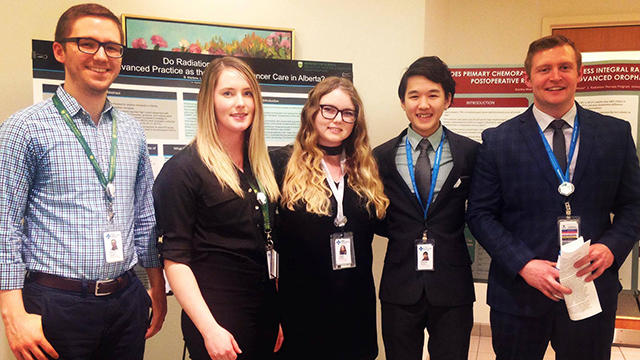
Being a unique cohort of only five students made them as close as family.
Their mentors refer to them as "the founding five." They consider themselves as guinea pigs of sorts. Merrill Singleton, Britny Martens, Chad Freeman, Logan Veldman and Stanley Woo are the first class of radiation therapists at the University of Alberta―trailblazers for future cancer care professionals.
Leaping into the unknown
The Faculty of Medicine & Dentistry's Bachelor of Science in Radiation Therapy program began accepting learners in September 2014. Singleton, Martens, Freeman, Veldman and Woo were the only students in the first class. It was a daily task to explain their novel profession to others who constantly mistook them for X-ray technicians or radiologists.
Radiation therapy is one of the main forms of cancer treatment, along with surgery and chemotherapy. It utilizes internal or external ionizing radiation to target the tumour and destroy cancerous cells while leaving healthy tissues intact. As Alberta's population ages and grows, there is an increasing need for qualified radiation therapists as part of the workforce who deliver more sophisticated forms of cancer care. Even though there are practicing radiation therapists in Canada and across the world, it is still an emerging professional field and only a few post-secondary institutions offer this specialized program in Canada.
Enrolling in a brand-new university program might be considered as a risky decision by some. Students like Freeman were up for the challenge.
"When the director said we would be the first ones in the program, I thought it was awesome. I see all those signs out there that say '100 years of medicine' or '100 years of dentistry'... Even though the profession of radiation therapy has been around for awhile, I think it was so cool to be the first ones here. When do you get the chance to pioneer a new program within a big university like the U of A?" said Freeman.
"I feel incredibly proud to be in the first group," agreed Veldman. "It was a pretty big risk for me, moving away from home and investing a lot of time and effort, however the risk really paid off."
Highlights of the program include the clinical time and interaction with patient actors and volunteers, plus their close work with the instructors and faculty.
"Although I know that I will continue to learn as I gain experience in the working world, this program gave me confidence that as a new radiation therapist I will be able to contribute to my team in a meaningful way right from the start," said Singleton.
Family ties

"When I found out that I would only have four classmates I was pretty curious to see how it would turn out," recalled Singleton. "I recognized that such a small class could amplify both the good and the bad―great classmates would make classes enjoyable, whereas difficult classmates would be hard to avoid."
While five students is a particularly small group, radiation therapy cohorts average 10 students every year to facilitate personalized learning.
"At the beginning, we were friendly to each other but different hobbies, interests, and backgrounds kept us a bit distant," said Woo. "But during the clinical simulation course we were put into scenarios where we had a lot of interaction. After that, I feel like we understood each other a lot better and were very close."
"We learned together, laughed together, annoyed each other and sometimes even sang together. It was an experience I will forever be grateful for and they are forever family to me," said Veldman.
"We used to joke amongst each other that we are more like siblings… In certain situations we would say, 'Yeah, we're pretty much like family now, you wouldn't do that in front of your friends!" added Martens, laughing. "We went through all of it together, the highs and the lows of the program. I'm sure we will stay in touch."
A two-way learning experience
Fostered by the Department of Oncology, the radiation therapy program at the U of A was designed to emphasize hands-on experience, clinical simulations and high-end technology to better prepare the students. They transition from classroom to clinical settings during their third year, refining their technical prowess and people skills. Their final simulation training happens at a cutting-edge training suite featuring real-life equipment, located within the Cross Cancer Institute. The students work with patient actors and former cancer patients who volunteered to simulate radiation treatment appointments.
The first class served as an opportunity for both faculty and students to look for improvement and build the program together.
"The faculty wanted things to work for us too, they didn't just respond to our comments with 'oh, we'll deal with it next year'," said Martens.
"I did like having the responsibility to help the program grow," added Woo.
"Witnessing the convocation of the first cohort of radiation therapy students is a great privilege. It marks the culmination of significant support, collaboration and the hard work of many people; the students, staff, administrators, faculty, radiation therapy practitioners, oncology clinicians, scientists and cancer patient volunteers, just to name a few," said Susan Fawcett, director of the radiation therapy program.
As members of the first radiation therapy class walk across the Jubilee stage on convocation day, they share Fawcett's joy and finish their program with their own lessons to pass on to future radiation therapy students.
"Even as a student, never underestimate the power you have to make a difference in a patient's life," said Veldman.
Want to know more about radiation therapy? Students walk you through the program in this video: